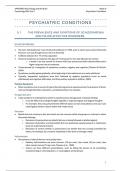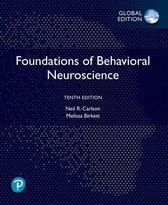4PAHPBIO Psychology and the Brain Week 9
Psychology BSc Year 1 Psychiatric Conditions
PSYCHIATRIC CONDITIONS
9.1 THE PREVALENCE AND SYMPTOMS OF SCHIZOPHRENIA
AND MAJOR AFFECTIVE DISORDERS.
SCHIZOPHRENIA
• The term ‘Schizophrenia’ was introduced by Bleuler in 1908, prior to which was named ‘Dementia
Praecox’ as it was thought to be a form of dementia
• It affects between 0.5-1% of the population
• Onset of symptoms are between the ages of 15-25 years for men and 30 years for women
o It tends to be less severe for women with less pronounced brain abnormalities and a
higher response rate to treatment
• Characterised by 3 categories of symptoms: positive, negative and cognitive (Mueser & McGurk,
2004)
• Symptoms usually appear gradually, often beginning in late adolescence or early adulthood
• Typically, depression symptoms arise first, followed by negative symptoms (such as social
withdrawal) and cognitive difficulties, and then positive symptoms (Häfner, 2000)
Positive Symptoms
• When symptoms are in excess of typical functioning and are experienced as the presence of them,
such as thought disorders, delusions, and hallucinations, for example
Thought disorders
• A key symptom of schizophrenia which is experienced as disorganised, irrational thinking
o It can be difficult to arrange thoughts logically or separate logical and illogical thoughts
o For example, they may jump between different topics as new associations come up or use
meaningless words to rhyme rather than make sense
Delusions
• Beliefs that are contrary to fact and which are not common within the groups or cultures to which
the person belongs
o Delusions of persecution are beliefs that one is being followed or plotted against
o Delusions of grandeur are false beliefs that one possesses special powers or importance
(such as supernatural powers)
o Delusions of control (similar to persecution) are beliefs that one is being controlled by
others, for example, by a receiver implanted in their brain or through a radar
Hallucinations
• Perceptions of stimuli that are not actually there
o Auditory hallucinations are most common (70 per cent), then visual (25 per cent), then
other senses (around 10 per cent, Mueser et al., 1990)
o Voices can have different presentations, such as telling the person to do something,
complimenting or criticising them, or meaningless words/phrase
1
,4PAHPBIO Psychology and the Brain Week 9
Psychology BSc Year 1 Psychiatric Conditions
Negative Symptoms
• Represent an absence or decrease of typical behaviours
Cognitive Symptoms
• Involves cognitive deficits, such as memory, attention, planning and decision-making
• Often overlaps with negative symptoms
Positive Symptoms Negative Symptoms Cognitive Symptoms
Hallucinations Reduced ability to start and continue Difficulty in sustaining attention
activities (avolition)
Thought disorders Reduced speech (alogia) Low psychomotor speed
Delusions Lack of initiative and persistence Deficits in learning and memory
Persecution Anhedonia (inability to experience pleasure) Poor abstract thinking
Grandeur Social withdrawal (asociality) Poor problem solving
Control Flattened emotional response
Typical Progression of Symptoms
1. Premorbid phase
• Occurs in childhood, with little to no symptoms
2. Prodromal phase
• Occurs in childhood/adolescence
• Brief positive symptoms may occur
• Often non-specific functional decline occurs,
such as difficulties in social communication and
mood or cognitive difficulties
3. Psychotic phase
• When the first psychotic episode typically occurs during adolescence/young adulthood
• Florid psychotic symptoms are present such as hallucinations, delusions and disordered
thoughts
• Usually, when the condition is diagnosed
4. Stable phase
• Can occur in adolescence, young adulthood or as an older adult
• Negative symptoms, cognitive and social deficits and functional decline occur
• Often punctuated by periods of psychosis
• However, other courses can be experienced after the first psychotic episode
o 8% will experience several psychotic episodes with functional impairment in between and
no return to normality
o 22% will experience one psychotic episode only and no further functional impairment
o 35% will have several psychotic episodes with a return to normality in between
o 38% will experience several psychotic episodes with increasing functional impairment in
between and no return to normality
Social Experiences of Schizophrenia
Having schizophrenia increases a person’s risk of:
• Unemployment • Recurrent hospitalisations
• Poverty • Having a comorbid illness and depression
• Homelessness • Suicide attempts (completion rate of 5-10%)
• Incarceration • Life expectancy being reduced by 1-3 decades
2
, 4PAHPBIO Psychology and the Brain Week 9
Psychology BSc Year 1 Psychiatric Conditions
AFFECTIVE DISORDERS
Description
• Primary symptoms are characterised by disordered feelings
• When affect becomes separated from reality and feelings such as depression or mania are not
justified by the events in their lives
• It is the 4th leading cause of disability (Kessler et al., 2003), affecting about 3 per cent of men and 7
per cent of women
• 15.9 per cent of people with MDD and 29.2 per cent of people with bipolar attempt suicide (Chen &
Dilsaver, 1996)
Major Depressive Disorder (MDD)
• Characterised by depression without mania
• Often comes in episodes but can be experienced as continuous
Depressive Symptoms
Emotions Thoughts Behaviour Physical
Sadness Self-critical Crying Slowing of bodily functions - constipation
or decreased saliva secretion
Anxiety Impaired Unable to experience Aches and pains
memory pleasure
Guilt Impaired Moving a talking slowly, Change in weight
concentration or increased movement
Anger Indecisiveness Loss of appetite for food Disturbed sleep
or sex
Helplessness Suicidal Social withdrawal Lack of energy
thoughts
Hopelessness Neglecting Chronic fatigue
responsibilities
Irritability Agitation Loss of motivation
Bipolar Disorder
• Characterised by alternating periods of mania and depression
• Episodes of mania can last from a few days to many months, with the periods of depression often
lasting 3 times as long as the mania
Manic Symptoms
Manic Mood & Behaviour Dysphoric Mood & Psychotic Cognitive
Behaviour Symptoms Symptoms
Going for long periods without sleep Depression Delusions Distractibility
Grandiosity Anxiety Hallucinations Racing thoughts
Engaging in goal-directed or impulsive Easily irritable, angry or Disorganisation
behaviours defensive if contradicted
Nonstop speech and motor activity Hostility Inattentiveness
Sense of euphoria, not justified by Violence
circumstances
Working on unrealistic projects Suicide
Excessive libido Irritability
3





